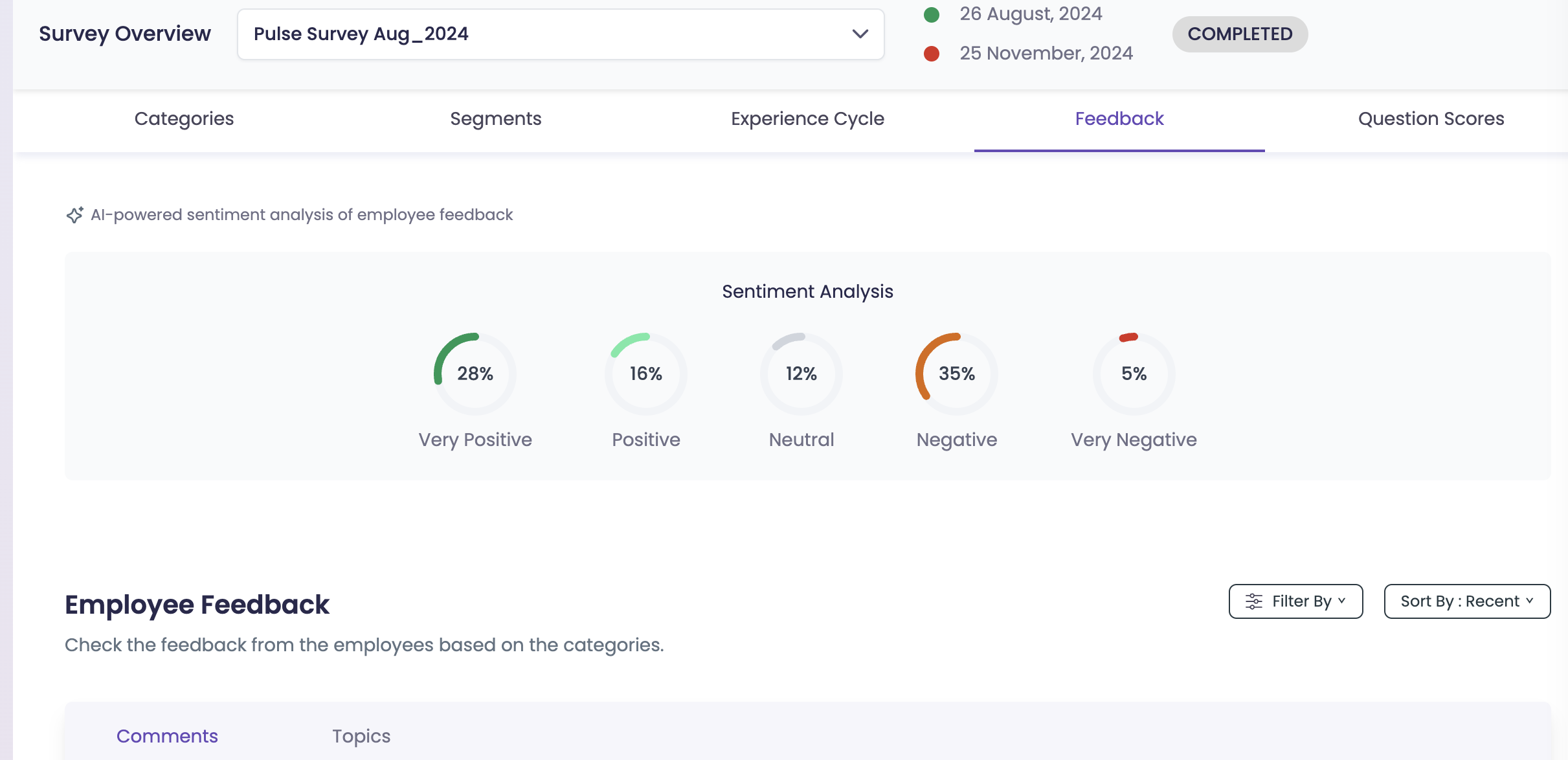What is Employee Morale: Signs, Strategies, and Solutions

A Global Employee Recognition and Wellness Platform
If you want to make your organization succeed and maintain a high-performance culture, employee morale is a key factor to consider.
High morale among employees can result in increased productivity, engagement, sustainability, and profitability. In contrast, low employee morale can destroy your organizational structure. It can increase cases of employee discontentment, workplace conflicts, and poor performance.
Whether you are the boss or an employee, low morale can be a killer.
-Ron Halversen, Clarity-Ventures
If ignored, low employee morale can cost you much more than reduced productivity. As per a study, low morale among employees costs the US $350 billion each year. Ouch!
The only way to save your business from the disastrous effects of low employee morale is to find creative strategies to identify and address issues before they escalate.
But before diving into ways to boost employee morale, let's first look at what is meant by employee morale.
What is employee morale?
Employee morale refers to the attitude and feelings employees exhibit towards their work and workplace. However, morale is not just about employee happiness or satisfaction. It also reflects how employees perform, approach their tasks, and align with the company's core values.
If you go towards a more formal employee morale definition, Roberts Wesleyan University describes employee morale as:
"Employee morale is the spirit of a person or group as exhibited by confidence, cheerfulness, discipline, and willingness to perform assigned tasks."
How does employee morale directly impact business performance?
1. Productivity
Employee morale and productivity go together. In fact, happy employees tend to be 13% more productive.
Employees' attitudes have a direct impact on their quality of work, efficiency, and performance. When people find genuine joy in their work, they start working with a can-do attitude. It also significantly boosts their confidence and performance.
2. ROI
Wondering how it can help you increase ROI? Have a look at these numbers-
-
Paid sick leaves cost employers around $160 billion annually.
-
The cost of absenteeism is roughly $3,600 and $2,660 per year for hourly and salaried workers, respectively.
-
Employee turnover can cost your organization 1.5-2 times the employee's salary. (Plus the damage done to the rest of the employees).
-
High-morale employees enjoy their job and feel invested in the company's success. You will see the effects in a reduced number of absentees, paid leave, and employee turnover. These reduced expenses will, in turn, boost your ROI in a domino effect.
3. Profitability
High morale raises profit in a clear chain of reactions. Motivated employees finish projects on time and within budget, cutting waste and unnecessary costs.
Not only that, but they are also extra cautious and share ideas for new products or services, which adds revenue. They also improve their customer service, resulting in happier customers, repeat sales, and positive referrals.
How to Spot and Measure Employee Morale?
It's essential to check morale regularly so you can address minor issues before they escalate into costly problems. The best way to achieve this is to combine complex data (such as surveys and turnover rates) with everyday observations to gain a comprehensive understanding.
Signs of Low Morale in the Workplace
-
Frequent absenteeism: Employees apply for frequent sick leave or arrive late more often than usual.
-
Negativity and cynicism: More complaints or pessimistic remarks during discussions.
-
High turnover: Rise in resignations as people look for better environments.
-
Declining productivity: Output drops while workload increases with each passing day.
-
Withdrawing from teamwork: Increasing tendency to avoid collaboration, meetings, or other social interactions in the office.
-
Lack of initiative: Few employees volunteer to come up with creative ideas or suggest improvements.
-
Customer service slips: More errors or poor interactions with clients, resulting in clear dissatisfaction.
The above symptoms are early warnings to start measuring morale. Now, let's see how we can start with it.
How to accurately measure employee morale?
-
For quick, regular check-ins, use Pulse Surveys .
-
To gather qualitative, personal feedback, one-on-one meetings are the best.
-
To understand why people, choose to stay with your organization, conduct stay interviews.
-
For analyzing feedback data and for scanning the overall mood- positive, negative, or neutral- use AI-based sentiment analysis.

12 actionable strategies to boost employee morale
Employee morale at your organization depends on a number of factors. Let's find out how you can increase employee morale by tweaking and improving a few of these factors-
Leadership and Communication Strategies
1. Transparent Communication

When it comes to improving employee morale, clear and transparent communication can play a huge role. Here are a few steps you can take to strengthen your internal communication-
Keep your people informed about every decision, policy, positive announcement, and product development. At the same time, be transparent about issues. In a survey, a whopping 74% of employees agreed to feel that they are missing out on company news and information.
-
Communicate your company strategies and goals regularly.
-
Encourage employees to voice their opinions and ask questions during meetings. Encourage collaboration with peers.
-
Clearly communicate their roles and what you expect from them.
-
Encourage employees to ask questions during meetings.
-
Foster a culture of collaboration and support by encouraging social recognition among peers.
-
Give your people a platform to voice their opinions with frequent internal surveys. And don't forget to follow up with your employees (anonymously, of course) to get a deeper insight into their concerns.

And make sure that collaboration and communication are among the top values your employees are recognized for. If they're not, time to step up your game!
A Gallup survey found that only 50% of employees know what their employer or manager expects of them. The lack of clarity about what is expected of them can lead to confusion, frustration, and procrastination on the part of your employees. In the long run, this can result in subpar performance, conflicts, and possible disciplinary action.
2. Train your leaders
Today, the most effective and influential managers think more like coaches and less like critics.
– Laith Dahiyat, CEO at Pingboard.
Employee morale is not something you can achieve alone. Your leaders and managers need to be aware. They need to understand the importance and impact of your initiatives.
Start with training them to be coaches instead of taskmasters or micromanagers. Train them in emotional intelligence and communication.
A survey found that 43 % of employees have left a job in the past because of a bad manager. In addition, 53 % of the employees said they plan to leave their jobs because of bad managers.
Help your leaders understand and recognize how their attitude can impact the whole team. Encourage them to work on the things that (can or ) are causing frustration and disappointment among employees or crushing their morale.
Recognition and Growth Strategies
3. Express gratitude and appreciation

Putting employees front and center with a consistent rewards and recognition system.
Employees who are recognized often show resilience in the face of challenges. They are ready to go over and above to take the company forward. It can boost morale by letting your employees know that their hard work and contributions are valued and appreciated.
Treat employees like they make a difference, and they will.
– Jim Goodnight, CEO and co-founder of SAS Institute.
Here are a few actionable steps to help you get started-
- Appreciate your people often. Even a simple "well done" or a shout-out at the end of meetings or gatherings can greatly boost their morale.
- Design a recognition program based on the AIRe framework. This magical framework enables you to make recognition genuine and impactful by attaching a strong emotional connection.
- Ensure your reward system allows on-spot recognition, pre-configured message templates, badges, shoutouts, and more.

- Incentivize your rockstar employees with monetary (e.g., points) and non-monetary benefits. Examples include points-based rewards, gift cards, volunteer time off, an annual travel stipend, and additional work-from-home days.

- Make recognition fair and equitable for all employees across multiple geographical locations with the SOLI framework.
- Instead of a "one size fits all" formula, customize and personalize your recognition program.
- Go for a white-labeled solution that will allow you to showcase your own unique branding even. In that way, even when your employees are using a different tool, a sense of community and belonging is reemphasized.
Want to know more about how Vantage Circle can help you design a recognition program more effectively?
4. Invest in Employee Growth and Development

A Gallup survey reported that up to 87% of Millennials look for development opportunities in a job. However, only 29% of employees are "very satisfied" with the advancement opportunities they are getting in their current job.
Invest in employee growth and development at your organization. Empower them with-
- Books or resources
- Introduce an LMS.
- Introduce them to a mentor.
- Let them work on cross-functional teams to broaden their horizon.
Even a small amount of their time dedicated to growth can give a huge morale boost among your people.
You can start your initiative by taking the time to learn which development goals are appropriate for your teams. Utilize one-on-ones for this purpose.
Culture and Well-being Strategies
5. Psychological safety
According to Deloitte, only 50% of workers believe their managers foster psychological safety on their teams.
It illustrates the extent of work that remains to be done in helping leaders understand that psychological safety is the foundation of efficient teams. It's the shared belief that your team is safe for interpersonal risk-taking.
In a psychologically safe environment, employees feel comfortable speaking up. They come up with new ideas, might ask a candid question, and are fearless about making honest mistakes once in a while. This trust helps build a culture of continuous learning and innovation.
For instance, you can try implementing "blameless postmortems" after a project failure. It allows the team to collectively analyze what went wrong, without blaming anyone individually. The goal is to shift the focus from "who" is at fault to "what" you can improve. This approach reinforces that vulnerability is not a weakness but a catalyst for growth.
6. Work-life balance
A balance between work and personal life is essential to maintain steady morale. It allows employees to rest, care for their families, or enjoy hobbies, and return to work with more focus and energy. Without this balance, employees are more prone to burnout and decreased productivity.
To facilitate this, companies can take simple steps. Like say, having flexible work timings, remote work options, or clear rules about no after-hours emails. Even a Fun-Friday can make a big difference.
These steps convey a powerful message that people are valued beyond their productivity and worth. Employees feel trusted to manage time, which builds loyalty and reduces turnover.
The data below backs this up:
-
83% of employees now rank work–life balance as a top priority, slightly higher than the 82% who prioritize pay.
-
Over half (56%) say they would trust their employer more if they were offered personalized benefits and flexible schedules.
-
37% would even accept lower pay in exchange for a richer social life.
7. Team connection
Those of your employees who feel connected to their work, colleagues, and the organization as a whole have high morale. You will often see them go above and beyond to achieve team goals.
In a survey, 80% of employees said they prefer working at an organization where they feel connected to their teammates. However, only 4% of HR respondents reported having adequately addressed the issue of employee connection at work.
Provide your people opportunities to get to know each other through team-building activities. Such as company events, team outings, or a spirit week celebration.
8. Fair pay
Fair pay is more than just salary- it is the core signal of organizational respect. When employees are confident that their hard work and efforts are valued appropriately and without bias, motivation and engagement rise. In contrast, uneven and inconsistent pay practices quickly lower morale and erode trust.
Thus, organizations that pair transparent pay structures with data-driven decisions see measurable results:
-
lower turnover,
-
stronger engagement scores, and
-
easier talent attraction.
At the same time, employees understand the "why" behind their compensation. It motivates them to focus on growth and performance instead of questioning equity.
9. Nurture employee health

Poor employee health can lead to increased stress, fatigue, and decreased productivity. These factors often make employees feel overwhelmed or unmotivated in their work and lead to a decrease in morale. Additionally, employees may become resentful if they feel their health is being neglected by their employer.
Want to know what it can cost you? Hold on to your seat and look at these startling numbers-
-
People with mental health issues like anxiety and depression are more likely to develop other physical health issues.
-
The cost of work stress is estimated to be as much as $187 billion.
-
The US economy is more than $210 billion annually in absenteeism and lost productivity.
Here's what you can do about it-
-
Prioritize employee health with a dedicated health-and-wellness program/ app. Such tools can keep them up and moving with new challenges every day. It can further help employees keep track of their daily water and calorie intake, calories burnt, step counts, and others.
-
Train your managers in skill sets that support mental health.
-
Incorporate health-related benefits like- health insurance, gym memberships, fitness or health education classes.
10. Have regular check-ins
Regular check-ins can improve employee morale by providing you with a consistent point of contact with the employees.
It lets you keep tabs on their progress, answer queries and address any potential issues before they intensify. Above all else, it helps you to get to know your people on a more personal level and offer the support they need.
Here are a few ideas to boost employee morale by making the most out of check-ins and 1-on-1 sessions-
-
Utilize 1-on-1 sessions to ask them about life outside work. Ask them how they are handling work stress and work-life balance. These little gestures of care can have a drastic impact on employee morale.
-
Offer a safe environment for people to share their thoughts, opinions, and feelings.
Provide managers and employees with guidelines so that employees can discuss private issues without fear of reprisal.
-Kevin Lee, CEO of JourneyPure.
- Ask questions that focus on the employee's development needs and goals. This will help you offer the resources and support needed for their success.
Workplace Environment Strategies
11. Create an inclusive space

Inclusion is what connects people to the business, and we believe it's one of the core reasons they stay.
-Eva Bak.
Diversity and inclusion create an environment where employees feel accepted and respected regardless of their differences. It can help you build trust between employees and management. Creating such a welcoming and supportive workplace can positively impact your employee morale.
Here are some steps and activities to boost employee morale by making your workplace more inclusive-
-
Rethink your organizational policies and rewire them to be more inclusive.
-
Form a Diversity and Inclusion Council.
-
Train and educate your managers and help them understand why it matters. Hold them accountable for their action.
-
Educate and encourage your teams to use inclusive language at work.
-
Make an inclusive R&R system where employees are recognized based on their job well done, regardless of their background. Thus, giving everyone a fair chance to shine.
-
Use DEI badges to appreciate the diversity champions who are making DEI an everyday reality for your organization.

12. Let go of negative influence
Negative interactions had a five-fold stronger effect on mood than positive interactions.
-Robert Sutton
If you want to preserve your employee morale and motivation, the first step is to let go of people damaging it. Even if they fall under the list of top performers, you will gain more than the value lost.
If you are still not sure if it's the right move or not, here's an HBS study that attempted to calculate the hidden cost of these negative influences-
"In comparing the two costs, even if a firm could replace an average worker with one who performs in the top 1%, it would still be better off by replacing a toxic worker with an average worker by more than two-to-one."
Special Considerations for Hybrid & Remote Teams
25% of fully remote employees report feeling lonely, compared with 21% of hybrid and 16% of on-site workers.
Work location is a big differentiator in employee morale. In the case of remote/ hybrid work, lower morale can be an issue due to communication and siloes causing slow decision-making. Thus, it's vital to stay intentional about connection, fairness, and inclusion before problems surface.
Here are some special considerations for your hybrid & remote teams:
-
Prevent isolation: Hold regular video check-ins and virtual social moments.
-
Ensure fairness: Apply the same performance standards and recognition for on-site and remote staff.
-
Equal access: Provide identical tools, training, and growth opportunities.
-
Transparent communication: Share updates openly so no group feels left out.
The Bottom Line
If you are witnessing low employee morale at your organization (in the form of higher turnover, chronic absenteeism, poor performance, or increased employee conflicts), it's high time to take action. Start with employee morale surveys and interviews to measure the employee morale rates and take action where needed.
Even if your employees are happy and engaged, take a stand before low morale creeps into your organizational performance. Keep making efforts to make your employees love working with you-it will go a long way!
After all, a happy and productive workplace is the key to success.
FAQs
1. Who is primarily responsible for employee morale- HR or direct managers?
In general, direct managers carry primary responsibility for day-to-day employee morale. However, HR provides the resources, tools, policies, and any other support to help managers succeed.
2. Our company offers great pay and benefits, so why is morale still low?
Great pay and benefits meet basic employee needs, but they don't guarantee morale. Low morale often stems from poor leadership, lack of recognition, limited growth opportunities, weak communication, or a disconnect from the company's vision. These are the areas that money alone can't fix and that need proper attention.
3. How can we protect morale during difficult times like layoffs or major restructuring?
During tough times, it's utmost important to maintain clear communication, visible empathy, fair treatment, ongoing recognition, and regular manager check-ins to keep trust and connection intact.
4. Do morale-boosting strategies differ for different generations in the workplace?
Yes. While basics like respect and recognition are universal, emphasis differs. Younger employees often value growth, flexibility, and a sense of purpose. On the other hand, the older generation may prioritize stability, fair rewards, and clear communication. Tailoring strategies to boost employee morale can have a significant impact across all age groups.
5. How do you make morale initiatives feel authentic and not just a corporate checklist item?
To make your initiatives authentic, involve your employees in shaping them. Work on their feedback, communicate with transparency, and model the behaviour yourself- so your action feels genuine and not just a checklist.
6. What kills morale in the workplace?
Several factors can kill employee morale in the workplace. This includes lack of recognition, poor communication, unclear job expectations or goals, lack of psychological safety, micromanagement, lack of growth opportunities, and high levels of stress or workload. Unfair or unethical practices, such as favoritism or discrimination, can also take a toll on morale.
















